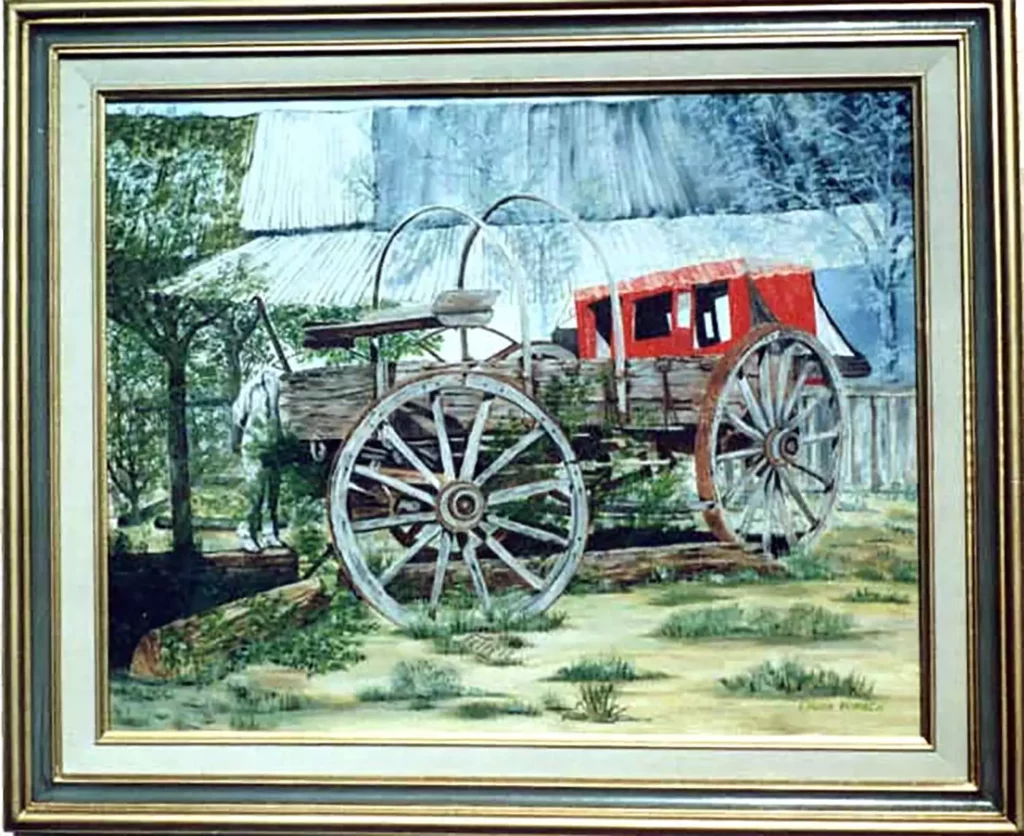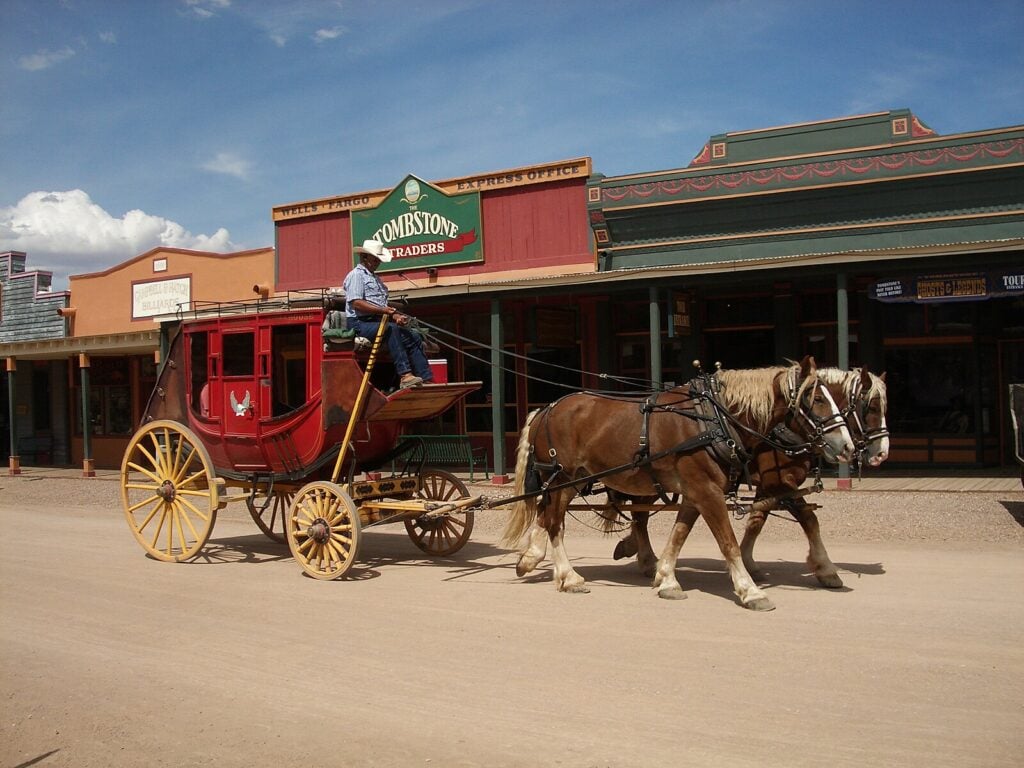Previously: Trimper’s Carousel.
Type: CO (Cursed Object).
Period/location of origin: 1994, Sierra Vista, Arizona.
Appearance: Subject — often erroneously referred to as “The Stagecraft” haunted painting, although it would be more accurately termed “The Stagecoach” haunted painting for reasons discussed in sections of this report to follow — appears to be a 16 x 20-inch oil painting reproduced from a photograph taken in Tombstone, Arizona by photographer James Kidd sometime prior to 1994. The artist has been identified only as “Laura P.”

The painting depicts a bizarre amalgamation of a covered wagon of the variety in use across the American West and Midwest in the 19th century, and a reproduction red stagecoach — likely a Concord coach — used to provide tours of Tombstone to guests and visitors in the current day. The painting also features a ghostly, male-presenting figure standing to the left of the wagon-stagecoach.
The figure has no head.
[Like what you read? Check out Dangerous Games To Play In The Dark, available from Chronicle Books now!]
Modus operandi: Subject’s modus operandi appears to be simply causing as much mischief as possible, so as to upset or disquiet witnesses or targets within its vicinity. Witnesses and targets who have experienced activity around or near subject may therefore consider the painting haunted or cursed.
If hung upon a wall, witnesses report that the painting will routinely become crooked. Even if righted, it will become crooked again shortly thereafter. It is seemingly impossible to hang straight.
An office in which subject once hung found appointments and meetings recorded within calendars, agendas, etc. would move around, suddenly becoming listed at incorrect times and causing confusion. Papers and documents would also regularly go missing.
A garage in which subject was once stored developed roofing issues; leaks appeared, and persisted despite numerous repairs. The leaking issues stopped only once the painting was removed from the garage.
When kept within a household, messes with no apparent cause, such as spilled salt from a shaker that remained upright, allegedly occurred; items hung upon walls within said household would not just fall, but reportedly “sail across the floor about six or seven feet,” according to one account; delicate items would break in such a way as to pose danger to those present — for instance, a seemingly intact drinking glass would suddenly develop large, sharp chips not previously observed, just as someone attempted to drink from it; knocking sounds reportedly occurred with no apparent cause; and, in one instance, a hazy apparition was observed within the home.
There are, of course, rational explanations for all of these events and occurrences that do not involve anything remotely paranormal or supernatural. Witnesses who have observed the events and occurrences, however, maintain that there is nothing normal or natural about any of them.
Containment: As of 2017, subject remains in the possession of its original creator.
Additional notes: The photograph upon which subject is based was originally taken in Tombstone, Arizona. It is primarily the result of an accidental double exposure; photographer James Kidd reportedly snapped first a photograph of a barn and wagon, and then later of a stagecoach in Tombstone. The resulting image combines the wagon and the stagecoach into a curious vehicle that does not, in reality, exist.
The photograph, however, also features a headless figure which may or may not also be a result of the double exposure. The photograph is frequently referred as a ghost photograph by those who believe the figure is, in fact, paranormal in nature.
The identity of the figure is not known.

James Kidd, sometimes credited as James Lee Kidd, James L. Kidd, or simply Jim Kidd, spent much of his career in the military, and later worked as a trucker. Originally from Texas, he and his spouse eventually settled in Tombstone, Arizona in 1980, at which time he had retired from both active duty and from trucking to pursue photography full time. In addition to being regularly displayed in galleries in and around Tombstone, his work has also been featured in books, magazines, newspapers, and television and film productions. In the mid-2000s, Kidd and his family relocated again to Sierra Vista, Arizona where he lived out the rest of his long, full life. Kidd passed away in 2021 at the age of 95.
The curious circumstances surrounding subject’s existence were first detailed for the public by the artist who produced the work, who identified herself only “Laura P.” Laura wrote about the painting and her strange experiences with it to paranormal researcher Stephen Wagner, who published Laura’s account at LiveAbout.com on Nov. 3, 2011. (The most recent update to this page occurred on Aug. 19, 2017; the original publication date may be retrieved by examining the page’s source code.) Laura P.’s account remains the only first-hand account of subject’s alleged activity which is publicly available.
According to Laura, she viewed Kidd’s original photograph in a gallery in Tombstone in 1994. She subsequently asked him for permission to create a painting based on his photography, which he granted.
Laura — who, incidentally, lived at the time in Sierra Vista, where Kidd would later move himself — began working on the painting when she returned home. As she worked, she says, she began “getting a strange feeling”; additionally, she found herself asking herself “why on earth” she wanted to paint this particular work, and wondered if perhaps she “should never have started it.” After she finished it, she began experiencing the strange occurrences previously described (see “Modus operandi”).
It is unknown why this painting is routinely referred to as “The Stagecraft.” It is not identified as such in the story’s original source; in fact, this original source — the LiveAbout article — does not title the painting at all. Additionally, the word “stagecraft,” which typically refers to the technical elements of a theatrical production, does not appear to have anything whatsoever to do with the painting — either its subject, or its manner of creation.
A theory: It is possible that the word “stagecraft” was, at some point early in the timeline of online discussions concerning subject, entered either as a typo or an autocorrect accident which went uncorrected before publication. “Stagecraft” is, after all, just a few letters off from the word “stagecoach”; given that the painting does clearly depict a stagecoach, it would be an understandable error to make (although how such an error would have escaped the editing process prior to publication is less clear). Subsequent discussion may have then failed to pick up on or challenge this error, and continued to use the title “The Stagecraft” despite its obvious incorrectness.
The earliest use of the word “stagecraft” in reference to this painting unearthed in the process of researching this current report occurred in a 2015 article published at CoolInterestingStuff.com. Although the painting is not titled here, the following sentence appears within the first paragraph of the article:
“Kidd had taken a photo of a stagecraft in Tombstone, Arizona and upon developing it noticed something surprising: perched on a log left of the wagon there was a figure that had not originally been present when the photo was taken; moreover, the figure appeared to be missing its head.”
The misuse of the word “stagecraft” to describe the painting’s subject occurred again in 2016 at Backpackerverse, where, similarly, the painting is not named, but includes the following sentence: “Kidd’s picture of a stagecraft has a surprising element: a head-less figure perched on the left of the wagon.”
“The Stagecraft” as a title for the artistic work appears to have initially been used in 2017 at the Malta-based website Ba-bamail.com in a listicle focused around cursed, haunted, or otherwise unusual paintings. According to this listicle’s source code, the original date of publication was Feb. 27, 2017. A listicle on the same topic published at Indian website ScoopWhoop subsequently occurred in April of 2018, at which time subject was again referred to as “The Stagecraft”; then, in 2020 and beyond, a wider discussion of subject began to emerge in online spaces, all of which continued to use the erroneous title “The Stagecraft.” The name seems, as the saying goes, to have stuck.
The painting is also sometimes referred to as “The Hanging Man.” This, too, appears to be the result of some sort of error; the ghostly figure seen in it is headless, not hanging. It is not known how or why this moniker became attached to the image.
It is also worth noting that, although some sources state that the painting has been destroyed — some specifying that it was burned — the original source for the story, Laura P. herself, has said no such thing. Indeed, according to the artist’s tale as published at LiveAbout, she and her spouse still have the painting “hanging in our house.” She notes that occasionally, people ask her if they can buy the painting from her; however, she states that she is “afraid to sell it,” for fear of what havoc an “unhappy ghost” might wreak on the lives of whoever dared to purchase it.
Recommendation: The activity surrounding subject may be nothing more than coincidence…
…But it’s probably best not to hang the painting in your home, anyway.
Just in case.
Resources:
The Haunted Painting at LiveAbout (artist Laura P.’s original account).
Headless Man at ClantonGang.com (James Kidd’s photograph).
Haunted Painting – Painting Of A Paranormal Photograph at CoolInterestingStuff (earliest known use of “stagecraft” terminology).
“The Gallery Hosting Jim Kidd For July” at the Douglas Dispatch (promotion of a 2011 James Kidd gallery showing).
James “Jim” Lee Kidd obituary at Tribute Archive.
***
Follow The Ghost In My Machine on Bluesky @GhostMachine13.bsky.social, Twitter @GhostMachine13, and Facebook @TheGhostInMyMachine. And for more games, don’t forget to check out Dangerous Games To Play In The Dark, available now from Chronicle Books!
[Images: Laura P.; tifoultoute/Wikimedia Commons, available via a CC BY-SA 4.0 Creative Commons license.]
Leave a Reply